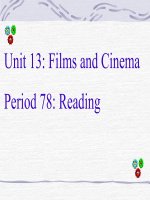unit 13 reading
Bạn đang xem bản rút gọn của tài liệu. Xem và tải ngay bản đầy đủ của tài liệu tại đây (844.11 KB, 13 trang )
<span class='text_page_counter'>(1)</span><div class='page_container' data-page=1></div>
<span class='text_page_counter'>(2)</span><div class='page_container' data-page=2>
Unit 13 :
Unit 13 :
Film and Cinema
<sub>Film and Cinema</sub>
Period 1
Period 1
:
<sub> : </sub>
Reading
<sub>Reading</sub>
</div>
<span class='text_page_counter'>(3)</span><div class='page_container' data-page=3>
Tom and Jerry Full house Conan
Kingkong Harry porter
- <i><b>Cartoon</b></i><b> -</b> -<i><b>Romantic film</b></i> - - <i><b>Detective film</b></i>
</div>
<span class='text_page_counter'>(4)</span><div class='page_container' data-page=4>
-I. Warm up:
I. Warm up:
II. Before you read:
II. Before you read:
1. New vocabulary:
1. New vocabulary:
2. New structure:
2. New structure:
III. While you read:
III. While you read:
1. Task 1:
1. Task 1:
2. Task 2:
2. Task 2:
3. Task 3:
3. Task 3:
IV. After you read:
IV. After you read:
V. Homework:
</div>
<span class='text_page_counter'>(5)</span><div class='page_container' data-page=5>
<b> </b>
<b>Vocabulary:</b>
Sequence
['si:kwəns](n) : sự nối tiếp, chuỗiScene
[sin](n): bối cảnhMotion
['mou∫n](n): sự chuyển độngCharacter
['kỉriktə](n): nhân vậtRapidly
['rỉpidli](adv): một cách nhanh chóngAudience
['ɔ:djəns](n): khán giả</div>
<span class='text_page_counter'>(6)</span><div class='page_container' data-page=6>
<b>New structure:</b>
<b>New structure:</b>
+ Form: It was not until
+ Form: It was not until ttimeime that that clauseclause
+ Meaning: This structure means the same as not…before.
+ Meaning: This structure means the same as not…before.
Eg: It was not until last year that we began this program
Eg: It was not until last year that we began this program= =
We did not begin this program before last year=We
We did not begin this program before last year=We
began this program last year.
began this program last year.
+ Use: This structure is used to emphasize the
+ Use: This structure is used to emphasize the
commencement point of an action or event in the past.
</div>
<span class='text_page_counter'>(7)</span><div class='page_container' data-page=7>
III. While you read:
III. While you read:
Task
Task
1:You are going to read the passage about the 1:You are going to read the passage about thehistory of cinema silently and then do Task 1.
history of cinema silently and then do Task 1.
1………….……….
1………….……….
2………..
2………..
3………..
3………..
4………..
4………..
5………..
5………..
6………..
6………..
Film-making industry
Film-making industry
Series of related events or actions
Series of related events or actions
A period of ten years
A period of ten years
Quickly and in a short time
Quickly and in a short time
Part of a film
Part of a film
A person in a film
</div>
<span class='text_page_counter'>(8)</span><div class='page_container' data-page=8>
Task 2:
Task 2:
You are to read You are to read the passage again and answer the passage again and answerthe questions in the book:
the questions in the book:
1. When did the history of cinema begin?
1. When did the history of cinema begin?
In the early 19In the early 19th th century. (line 1).century. (line 1).
2. What did scientists discover at that time?
2. What did scientists discover at that time?
At that time the scientists discovered that when At that time the scientists discovered that when
sequence of still pictures was set in motion, they
sequence of still pictures was set in motion, they
could give the feeling of movement .(line 2-3).
could give the feeling of movement .(line 2-3).
3. Did films in the early days have sound?
3. Did films in the early days have sound?
No, they didn’t .(line 5,line 13-15).No, they didn’t .(line 5,line 13-15).
4. When were audiences able to see long films?
4. When were audiences able to see long films?
</div>
<span class='text_page_counter'>(9)</span><div class='page_container' data-page=9>
5. When was sound introduced?
5. When was sound introduced?
At the end of the 1920s.(line 14).
At the end of the 1920s.(line 14).
6. What form of films appeared as the old silent films
6. What form of films appeared as the old silent films
were being replaced by spoken ones?
were being replaced by spoken ones?
The musical cinema. (line 17)
</div>
<span class='text_page_counter'>(10)</span><div class='page_container' data-page=10>
Task 3:
Task 3:
Read the passage one more time and find the Read the passage one more time and find themost suitable title for it.
most suitable title for it.
A
A
. The story of Film Maker.
. The story of Film Maker.
B. A Brief History of Cinema.
B. A Brief History of Cinema.
C. The History of the Film Industry.
C. The History of the Film Industry.
</div>
<span class='text_page_counter'>(11)</span><div class='page_container' data-page=11>
After you read:
Work in groups: Talk about the passage, using
the cues below:
19thcentury
1905
1910s
1915
1920s
History of cinema began
Films were about 5-10minutes long
The first long films were made
Films became even longer and
better. Cinemas were first built
Sound was introduced and old silent
films were replaced by the
</div>
<span class='text_page_counter'>(12)</span><div class='page_container' data-page=12>
Homework:
Homework:
* Make sentences with new words
* Make sentences with new words
* Write a summary of the passage using
* Write a summary of the passage using
your note taken for the “After you read”
your note taken for the “After you read”
task
</div>
<span class='text_page_counter'>(13)</span><div class='page_container' data-page=13>
Class is over.
Class is over.
</div>
<!--links-->









